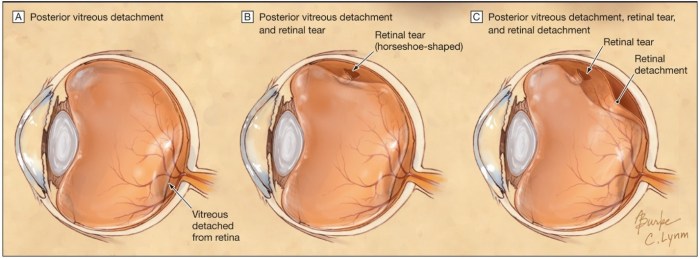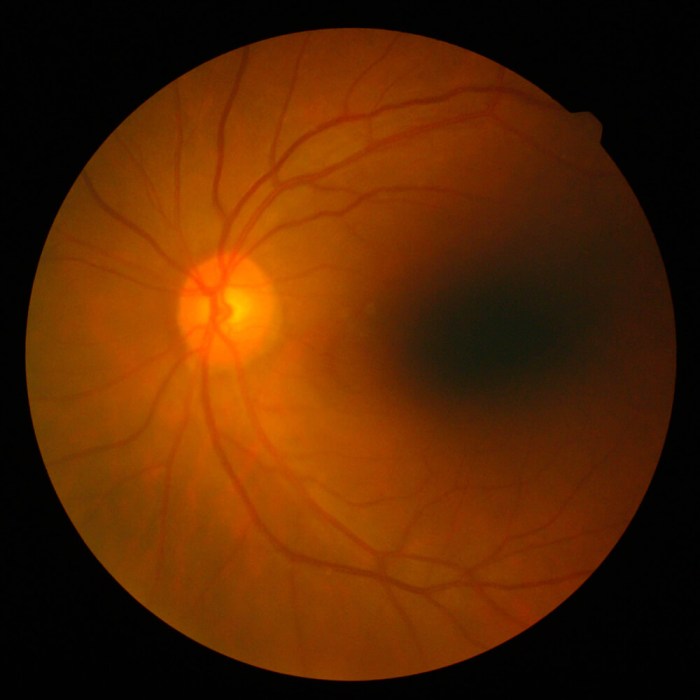In retinal detachment vitreous humor seeps behind the – In retinal detachment, vitreous humor seeps behind the retina, leading to a potentially severe condition that requires prompt medical attention. This article delves into the composition, role, and impact of vitreous humor in retinal detachment, providing insights into its causes, symptoms, and management.
The vitreous humor, a gel-like substance filling the eye’s posterior chamber, plays a crucial role in maintaining the eye’s shape and transparency. However, in retinal detachment, the vitreous humor can seep behind the retina, causing it to detach from the underlying choroid.
This detachment disrupts the normal function of the retina, leading to vision problems and potentially blindness if left untreated.
1. Vitreous Humor
The vitreous humor is a clear, gel-like substance that fills the space between the lens and the retina in the eye. It is composed of 98% water and 2% collagen and hyaluronic acid.
The vitreous humor plays a crucial role in maintaining the eye’s shape and transparency. It helps to keep the retina in place and prevents it from detaching. The vitreous humor also provides nutrients to the retina and helps to remove waste products.
2. Retinal Detachment

Retinal detachment occurs when the retina separates from the underlying layer of the eye, the choroid. This can happen as a result of trauma, inflammation, or a tear in the retina.
Symptoms of retinal detachment include:
- Floaters
- Flashes of light
- Blurred vision
- Loss of peripheral vision
- A curtain or veil over the vision
3. Vitreous Humor in Retinal Detachment: In Retinal Detachment Vitreous Humor Seeps Behind The
In retinal detachment, the vitreous humor seeps behind the retina and separates it from the choroid. This can happen if the vitreous humor becomes too fluid or if there is a tear in the retina.
The vitreous humor can have a significant impact on the progression of retinal detachment. If the vitreous humor is too fluid, it can put pressure on the retina and cause it to detach further. Additionally, the vitreous humor can contain cells that can damage the retina.
4. Management of Retinal Detachment

The treatment for retinal detachment depends on the severity of the detachment and the underlying cause.
Surgical techniques used to repair retinal detachment include:
- Scleral buckle
- Pneumatic retinopexy
- Vitrectomy
The vitreous humor plays a role in surgical interventions for retinal detachment. In vitrectomy, the vitreous humor is removed and replaced with a clear fluid. This allows the surgeon to see the retina more clearly and to repair the detachment.
5. Prevention of Retinal Detachment

There are a number of things that can be done to reduce the risk of retinal detachment, including:
- Avoiding eye injuries
- Wearing protective eyewear when playing sports or doing other activities that could cause eye injury
- Getting regular eye exams
FAQ Guide
What are the symptoms of retinal detachment?
Symptoms of retinal detachment include sudden flashes of light, floaters, a dark curtain or veil over the field of vision, and distorted vision.
What causes retinal detachment?
Retinal detachment can be caused by various factors, including eye trauma, lattice degeneration, posterior vitreous detachment, and certain medical conditions such as diabetes and high blood pressure.
How is retinal detachment treated?
Treatment for retinal detachment typically involves surgical intervention, such as scleral buckling, pneumatic retinopexy, or vitrectomy. The specific technique used depends on the severity and location of the detachment.